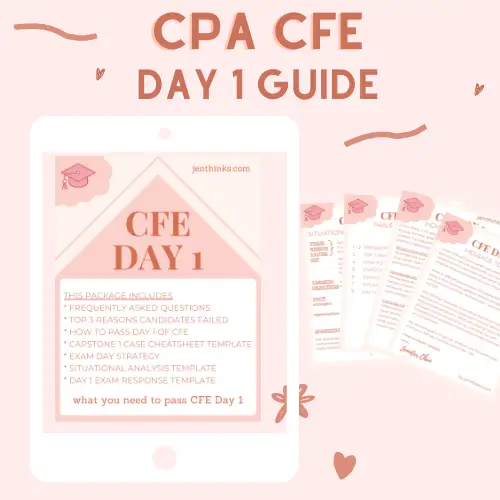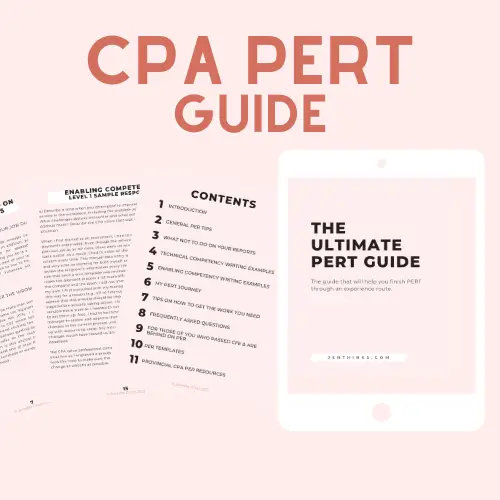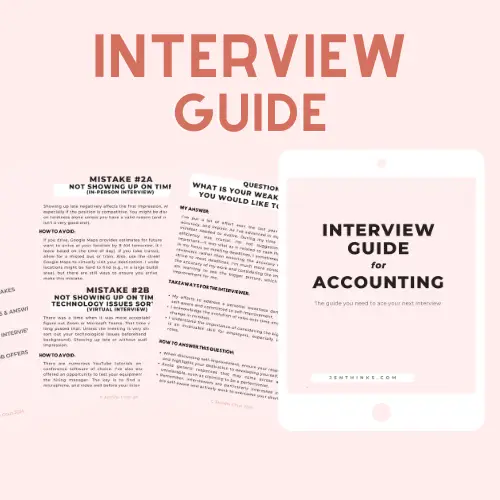Click here to get your free copy of Top 3 Reasons Candidates Failed CFE Day 2
My group submitted our recorded presentation for Capstone 1 for our Waste Disposal Inc case last Friday. Capstone 1 felt longer than it was in reality (8 weeks). I attribute this feeling to the number of meetings (average 1 to 2 per week) and amount of collaboration involved. There was quite a bit of work involved for the last part of Capstone 1 (Part 3 & presentation) and hopefully my tips will help make it easier for you. Also, I will provide my final thoughts on Capstone 1 as a whole at the end of this post.
Read All CPA Capstone 1 Posts Here
Capstone 1 Week 6 to 8 Submissions & Tips (Part 3 & Presentation)
| Timeline | Submission(s) |
| Week #6 | Group: 3 Questions for the Facilitator Individual: Peer Assessment, Self Assessment |
| Week #7 | Group: Part 3 of Capstone 1 Report (7,000 words) |
| Week #8 | Group: Recorded Presentation or In-Person Presentation Individual: Module Survey |
Questions for the Facilitator
For both facilitator calls, even though our group submitted only 3 questions (as per the assignment instructions), we prepared more than 3 questions before the meeting. This is because the facilitator will most likely finish answering the 3 submitted questions before the 30-minute is up. This call will be a great opportunity to ask your facilitator any question regarding Part 3 (your final written submission) and the presentation.
Of course, you can always email your facilitator with your question or ask your questions on the discussion board. Before you make your post, make sure to browse the discussion board first as many questions might have been asked already. This will save your time by not having to wait for the facilitator(s) to respond.
Self-Assessment & Peer Assessment
- self-assessment is pretty straightforward and it took only 10 minutes to complete (if not shorter)
- for peer assessment, compared to the last time you submitted it (Week #2), more time has passed
- like last time, do not need to create problems if there aren’t any
- however, this will be your last chance to bring up an issue if it’s serious (trying to resolve with the group member(s) directly first is still recommended)
Part 3 of Capstone 1 Report
- refer to Week #7 instructions and use the task list like a checklist for Part 3
- refer to sample Part 3 reports (you should be given two) to determine the format and level of details
- when there is a discrepancy between the sample report and Week #7 instructions, follow Week #7 instructions
- before you even start working on the Part 3 of the report, review Part 1 & Part 2 as a group
- you are expected to incorporate feedback from your facilitator for your Part 1 & 2 even if revision was not required
- what my group did was the following
- reviewed our work against the feedback guide and check to see if we can remove any content that was not required for marks (e.g., a long introduction that can be replaced with the Executive Summary of Part 3) to save some word count for Part 3 (you will need it)
- revise our parts if they were awarded a RC or lower
- you should be familiar with how exhibits are counted by now but continue to work on
- condensing past exhibits from Part 1 & 2
- keeping track of both Word and Excel exhibits as they share the same limit (25 page)
- only submit your work to D2L when it is final
- if you have not read my tips for this from Part 2, click here
- note, this point is even more important as there is no revision opportunity for Part 3
- avoid submitting the wrong file at all costs (even if your facilitator allows you to re-submit)
- assign one of your groupmates to be a floater
- floater is someone who is not assigned a part or only assigned a small part of the report so he/she can be available to help out when needed and also to put the report together
- I marked this tip as OPTIONAL for Part 2 but I think this role is critical for Part 3 because of the size (7,000 words & 25 pages of exhibits) and importance (no revision opportunity)
- having a floater does not remove the need for every group member to review the report in full
- everyone has the same level of responsibility to ensure the report is as accurate and complete as possible
- (OPTIONAL) fill out the PowerPoint slides for your presentation as you work on your Part 3
- this is optional as my group started a Google Slide around the same time we started working on Part 3
- however, we did not end up working on the slides much until after we submitted our Part 3
Recorded Presentation or In-Person Presentation
Recorded Presentation
Note, I took Capstone 1 from May to Jul 2021 when social distancing rules were still in place. Depending on what rules are in place when you take Capstone 1, you might be asked to record your presentation (what I did), present live online on a Zoom call (what CPA Ontario candidates did during the same period) candidates or present with your group in-person.
There are 2 ways your group can record your presentation: record together on a Zoom call or record separately (have the option to either put the clips together as a complete video or submit separately). My group chose to record separately and one of my groupmates put the video clips (~15 short clips) together at the end. We made sure to allocate the time per person beforehand so there would not be any editing/cutting involved. This approach worked out well except for minor hiccups (e.g., introducing the wrong group member). We agreed as a group to not nitpick minor flaws as re-recording will take a long time (no guarantee it will be perfect the next 10 times anyway).
We worked on the presentation slides on Google Slide as it allowed for online collaboration. We then downloaded the file as .pptx (Microsoft PowerPoint file extension) and kept only our own slides. I posted this quick tutorial on my Instagram story if you need assistance with recording.

For the Q&A, your group might be requested to attend a meeting to answer questions up to 3 days after your submission. However, I have not personally come across any group that did Capstone 1 in this format who got the request.
In-Person Presentation
By the time you read this post, hopefully all the social distancing rules are lifted. If so, chances are you will be presenting in-person in front of a panel. This Reddit post written by a previous Capstone 1 presentation marker provided a lot of valuable tips for the presentation. The only thing I have to say is practice enough so you know your materials, get familiar with your group members’ slides so you can help if needed and just relax.
Your group will be asked questions by the panel right after your presentation (both in-person and online live format). To pass, each and everyone of you is expected to answer at least one question. The author of the Reddit post I linked earlier suggested a really great way to ensure everyone gets a chance: assign a leader who is familiar with who did which part so he/she can assign the questions evenly.
Final Thoughts on Capstone 1
Capstone 1 Is Still Quite A Bit of Work Even Though It Is Only A Pass/Fail
I have not come across anyone who knows someone who has failed Capstone 1. That means, if you put in the effort and follow the rules (e.g., format, deadlines etc.), you will pass this module no problem. However, that does not mean that Capstone 1 is easy. I was quite lucky with my groupmates as all of them were punctual and responsible. We met online at least once a week (twice towards the end) and most meetings lasted close to 2 hours. I believe not all groups met this often or for this long, however, I found our meetings really productive. On top of that, we communicated in a group chat on Whatsapp regularly.
My biggest tip for minimizing work for Capstone 1 would be to follow the weekly instructions PDF closely so you will not get any NA (not addressed). We only had to submit revision for our Project Plan and that interrupted our flow for the parts we had to work on next. We learned from our mistakes and did not have to submit revision for any submission after.
Working In A Group Means Compromises
I am not a perfectionist and I tend to prefer efficiency over perfection. It works fine when I am working on my own assignments as I bear all the consequences. This can be a concern if your group members are the opposite. There was no major conflict (or even minor) when I did Capstone 1 but there were times when I wished we would be done already. The key is to find a balance. If it is something truly trivial, I would suggest to my group that maybe we should overlook it. On the other side, if it is something critical, I would respect my group members’ wishes and continue working on it. After all, it is their project as much as it is yours.
Capstone 1 Candidate Guide Addendum
Being familiar with the rules will make your Capstone 1 life easier. Also, when in doubt, contact your facilitator directly. I say this because of the slight variations between how the facilitators interpret the rules and some are more lenient than others (rules are rules after all). Do not forget to be nice and patient to your facilitator as all of the ones I have encountered are helpful and fair.
You Might Resent The Work During The Module But You Do Learn From It
I would be lying if I tell you I did not whine about the “meaningless” work during Capstone 1. I did more than once at several points of the module. I was tired from work, CFE prep and found no joy in analyzing for a waste disposal company (I swear I would have been more passionate if I was working on the hotel case). However, when the final report was coming to fruition towards the end, I understood why Capstone 1 was part of the CPA PEP journey. Thanks to the 7 weeks of hard work, the final report (Part 3) turned out to be more professional than I could have imagined. When I was reviewing it, I thought to myself, “so that’s what CPAs were paid to do.”
It Would Be Quite Challenging to Work On CFE Prep During Capstone 1
I went back to my CFE diary and confirmed that I basically stopped CFE Prep completely towards the end of Capstone 1. The fatigue finally caught up to me. Since I had started my technicals reivew for CFE several months ago (earlier than most and definitely not necessary), I did not force myself to stay on schedule. Keep this in mind if you plan on starting technicals review the same time as Capstone 1.
However, keep in mind that the case for your Capstone 1 is directly related to Day 1 of CFE. That means you are working on CFE Prep just by working on Capstone 1.




Comments are closed.